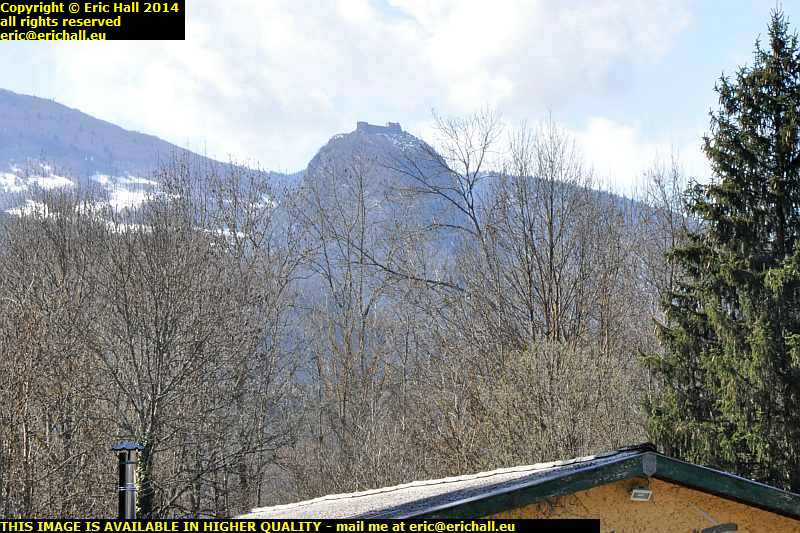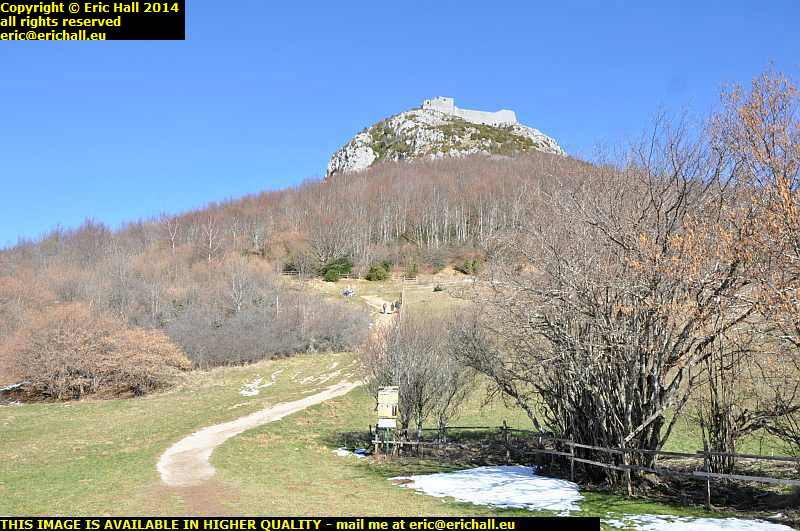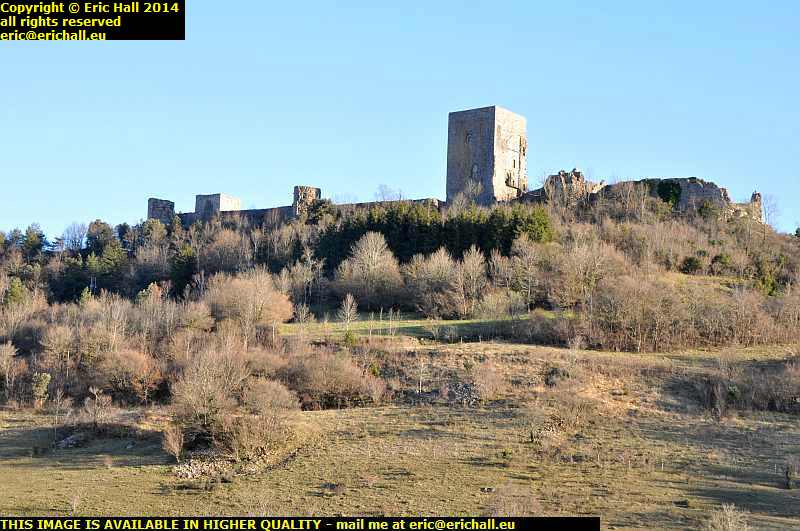And in case you are wondering where Quillan might be, it’s back in France again in the Département of the Aude about 50kms from Carcassonne.
But I’m not going to Carcassonne (well, at least, not yet) – I’m going to somewhere quite different, more of which anon
Today, though, I left Andorra nice and early in the bright sunlight and to cheer me up even more, I found a petrol station selling diesel at 111.3 cents per litre, which has to be the cheapest that I can get anywhere in Europe.

The climb up and out of Andorra was rather fraught though. They were still dealing with the after-effects of the heavy snowfall the other day, and what wasn’t helping matters was that there was a really strong wind up aloft. That’s not a cloud coming over the top of the mountains – that’s the snow being whipped off by the wind.
I was going that way too and the higher the road climbed into the mountains, the worse the road became. But while there weren’t any problems, it was still uncomfortable.
What didn’t help matters was that the snowploughs had not been able to clear the parking areas at the ski resorts. Consequently, all of the holidaymakers simply abandoned (I refuse to use the word “parked”, as “parked” they certainly were not) all over the sides of the roads by the ski lifts regardless of the snowploughs and the moving traffic. It was total chaos in quite a few spots and had I been an Andorran policeman, all of the cars would have been towed away.
Thoughtless was not the word. Pig-ignorant and selfish are far better.

Now, how about this for something? That castle perched up there on that rock in the distance is one of the most enigmatic places in the whole of France and was on the top of the list for me to visit. It’s the reason why I’ve come down here.
It’s the Chateau de Montségur and while it can’t match Béziers for being the place of the greatest massacre of French civilians (well, okay, they weren’t French back in the 13th Century), what happened at Montségur is one of the most mysterious and bewildering events ever to occur in what is now France.

Somewhere round about where that monument is (no-one can be exactly sure where the exact spot might have been) on 16th March 1244, approximately 225 Cathars and Cathar sympathisers were put inside a cage and were burnt to death.
And it has to be said that they were quite happy with the idea, to such an extent that about 20 of the victims actually volunteered to go to their doom. One eye-witness report tells of the Cathars singing as the flames were engulfing them.
 In brief … "thank goodness" – ed … Catharism was a religious sect that dissented from the teachings of Rome. Cathars were Christians without a doubt, but nevertheless their manner of worship and their beliefs were considered heretical by the Pope.
In brief … "thank goodness" – ed … Catharism was a religious sect that dissented from the teachings of Rome. Cathars were Christians without a doubt, but nevertheless their manner of worship and their beliefs were considered heretical by the Pope.
Catharism was quite strong in this region and some of the wealthiest landowners were Cathars. Consequently, other local notables didn’t need much encoragement to urge the Pope to declare a Crusade against the Cathars.
Béziers was one of the first Cathar towns to fall and it is said that maybe as many as 20,000 people in the town were burned alive.
It was reported that someone asked “who shall we burn? How do we know which ones are Cathars?”
The reply was quite simple. “Burn them all. God will recognise his own”.
 But as the noose slowly tightened around the Cathar region, the rock of Montségur was fortified and turned into a refuge of the last resort. Little by little, refugees arrived here bringing with them the religious treasures and relics from other Cathar centres that had succumbed. In 1243 there were 500 people living on the rock, all prepared to make a last stand.
But as the noose slowly tightened around the Cathar region, the rock of Montségur was fortified and turned into a refuge of the last resort. Little by little, refugees arrived here bringing with them the religious treasures and relics from other Cathar centres that had succumbed. In 1243 there were 500 people living on the rock, all prepared to make a last stand.
Montségur by this time had already withstood several sieges but in May 1243, with opposition elsewhere being almost totally crushed, the whole might of the Crusade laid siege to the rock and slowly but surely, fought their way up the hill.
 By Christmas 1243 it was clear that the garrison could not hold on for much longer and in a daring escape, several of the parfaits, as the Cathar monks and nuns were known, took the entire treasure that had accumulated inside the castle, and disappeared with it to a place of safety. What became of it, no-one ever knew and no trace of it has ever been discovered to this day.
By Christmas 1243 it was clear that the garrison could not hold on for much longer and in a daring escape, several of the parfaits, as the Cathar monks and nuns were known, took the entire treasure that had accumulated inside the castle, and disappeared with it to a place of safety. What became of it, no-one ever knew and no trace of it has ever been discovered to this day.
Even more incredibly, one of the escapees managed to return to the castle and he was there on 1st of March 1244 when the castle finally called a truce. The terms of the truce (which was effectively a surrender of course) was that the civilians could leave unmolested, but any parfait (there were said to be about 200 or so in the castle) who failed to renounce his or her vows would be burnt to death.
 The defenders asked for a 15-day truce (why, no-one knows) and this was accorded. And on the eve of the final day, an important ceremony of some nature was held within the castle. Later that evening, a few more parfaits slipped out of the castle, taking with them the final objects of importance that had (presumably) been used at the ceremony. And all of that disappeared too, never to resurface.
The defenders asked for a 15-day truce (why, no-one knows) and this was accorded. And on the eve of the final day, an important ceremony of some nature was held within the castle. Later that evening, a few more parfaits slipped out of the castle, taking with them the final objects of importance that had (presumably) been used at the ceremony. And all of that disappeared too, never to resurface.
Next morning, the garrison surrendered. and it is said, quite astonishingly, that not only did no parfait renounce his or her vows, but another 20 or so claimed to have taken the vows in the meantime and demanded to be burnt – a request which of course was granted.
 So what was the treasure that was taken away at Christmas 1243?
So what was the treasure that was taken away at Christmas 1243?
Where was it taken to?
Why did the garrison demand a 15-day truce?
What was so important about the 15th of March that a truce was requested to cover that day?
What was the ceremony that took place on that day?
What were the objects that were used at the ceremony?
Why were they taken away?
Where were they taken to?
Why were so many people so happy to be taken away to their deaths?
There has been endless speculation about all of this and so many books and novels have been written that they could make a stairway up to the castle. But you can see why Montségur is a place of such interest to so many people.

This is another site in the Ariège that is associated with Cathars. It’s the village of Montaillou.
This is not the original site of the village, though. This is a more recent reincarnation. The village that we are interested in is the one that was in existence at the end of the 13th Century and this is about half a mile away from the present site. And unless you know where to look, you won’t find it at all.
 This chapel sitting down in a field dates from the 11th Century and it was at the foot of the chapel that the original village was situated.
This chapel sitting down in a field dates from the 11th Century and it was at the foot of the chapel that the original village was situated.
And so to set the scene, the fall of Montségur did not quite spell the end of Catharism in France. It lay dormant for probably 50 years but someone discovered several documents setting out the important tenets of Cathar belief, and he resurrected the religion. Montaillou was one of the most important “new Cathar” villages, so much so that a Papal inquisition descended on the place and arrested all of the inhabitants.
They were fully interrogated and their answers were fully recorded. There were indeed parfaits in the village but many escaped. One by one, though, they were tracked down and burnt to death
 So while you look at the site of the Medieval village and marvel at how clearly the traces of the roads and habitations show up through the snow after 7 centuries of abandonment and agricultural exploitation, let me tell you a little about what is so interesting about the village.
So while you look at the site of the Medieval village and marvel at how clearly the traces of the roads and habitations show up through the snow after 7 centuries of abandonment and agricultural exploitation, let me tell you a little about what is so interesting about the village.
If you remember my visit to Red Bay in Labrador in 2010
you’ll recall how a chance find in a dusty, forgotten archive led to a discovery of the 2nd-most-important historic site in Canada, something similar has happened here.
 While you look at the ruins of the castle of the Counts of Foix, situated on a hill nearby, I’ll tell you that someone by the name of Emmanuel Leroy Ladurie went a-ferretting in some dusty, forgotten archives of one of the local bishops, and actually discovered the verbatim records of the interviews between the members of the Papal Inquisition and the inhabitants of Montaillou.
While you look at the ruins of the castle of the Counts of Foix, situated on a hill nearby, I’ll tell you that someone by the name of Emmanuel Leroy Ladurie went a-ferretting in some dusty, forgotten archives of one of the local bishops, and actually discovered the verbatim records of the interviews between the members of the Papal Inquisition and the inhabitants of Montaillou.
He wrote a book (a copy of which is in my possession) to summarise the information gleaned from the interviews and it has become one of the most important references to life in rural France at the end of the 13th Century, adding a great deal to whatever was previously known about the subject.
 While we are on the subject of castles, this whole area is teeming with them. Not quite one on every hilltop but pretty much near enough.
While we are on the subject of castles, this whole area is teeming with them. Not quite one on every hilltop but pretty much near enough.
This is the Chateau de Puivert and was another Cathar stronghold. It fell to the Crusaders after a siege of just three days in November 1210 and the leader of the crusaders, Simon de Montfort, granted it to one of his marshalls.
As an aside, de Montfort was the father of the Simon de Montfort who opposed Henry III of England during the Barons’ Revolt of 1264-67. It was however Montfort père who was responsible for most of the atrocities committed against the Cathars during the early years of the Crusade.
 It wasn’t all work either. I’ve seen a couple of really interesting motor vehicles today, highlight of which has to be this German Hanomag Kurier light truck.
It wasn’t all work either. I’ve seen a couple of really interesting motor vehicles today, highlight of which has to be this German Hanomag Kurier light truck.
Apart from the fact that its engine is a diesel, I know nothing else whatever about it. Hanomag stopped making trucks in 1969 and so this gives me some idea of the date. I wouldn’t have put it many years earlier than that. Still, I’d take it home with me tomorrow given half a chance.